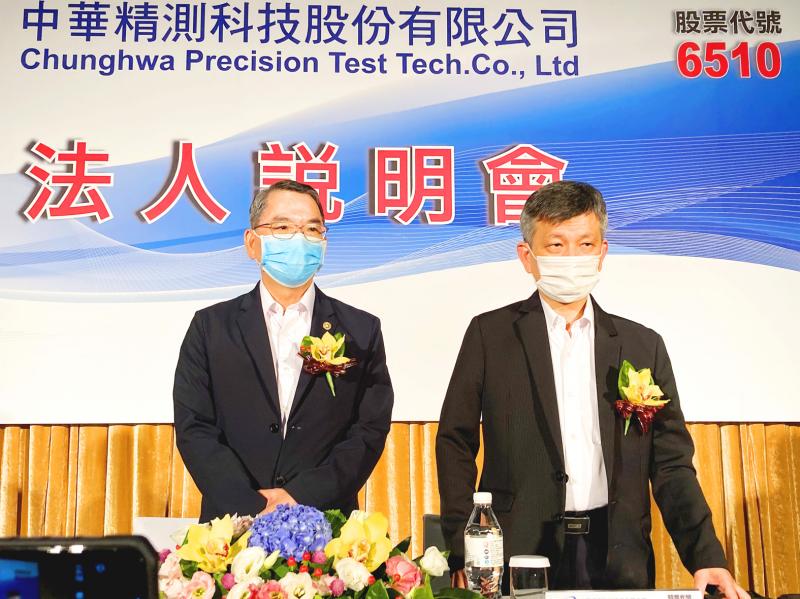Wafer probing services provider Chunghwa Precision Test Technology Co (中華精測) yesterday said net profit last quarter reached NT$233 million (US$7.9 million), its highest second-quarter revenue ever, and maintained a cautiously optimistic outlook for the second half of this year.
Net profit almost doubled from NT$118 million from a year earlier and rose 30.17 percent from the previous quarter’s NT$179 million.
Earnings per share jumped to NT$7.11, from NT$3.59 a year earlier and NT$5.46 a quarter earlier.

Photo: Lisa Wang, Taipei Times
In the first half of this year, net profit skyrocketed 95 percent year-on-year to NT$409.63 million from NT$212.48 million, with EPS increasing from NT$6.46 to NT$12.57.
Chunghwa Precision attributed the strong growth to resilient demand for its services for a variety of chips used in 5G smartphones.
With prices of 5G smartphones falling rapidly, Chunghwa Precision is optimistic about global 5G smartphone growth, chairman Lin Kuo-fang (林國豐) told an investors’ conference in Taipei.
Some 5G smartphones in China are priced as low as 2,000 yuan (US$288), Lin said.
Global shipments of 5G smartphones are forecast to reach 210 million units this year, making up about 17 percent of overall smartphone shipments, Chunghwa Precision said, citing a forecast by a local market consultancy.
The share of 5G phones is expected to jump to 42 percent next year, it said.
5G-related wafer testing services last quarter began contributing to the company’s revenue and should further expand this year, Lin said.
Growing 5G business should help gross margin stay between 50 and 55 percent this year, the company said, compared with 54.1 percent last quarter.
“We are cautiously optimistic about the [outlook for the] second half,” company president Scott Huang (黃水可) said.
Chunghwa Precision said rising demand for its vertical probe card business contributed to its optimistic outlook.
This business delivers a much higher margin than a tractional type of probing via load boards.
It is to make up 20 to 25 percent of the company’s overall revenue this year, compared with 12 percent last year, it said.
The company plans to introduce its first vertical probe card service for microelectronic mechanical system this quarter, it added.
Chunghwa Precision has been diversifying its product lineup and customers to avoid becoming overly dependent on a single customer after losing orders from Apple Inc two to three years ago.
The firm counts Huawei Technologies Co (華為), Taiwan Semiconductor Manufacturing Co (台積電) and MediaTek Inc (聯發科) among its major customers.
The company said its largest customer contributed less than 30 percent to its revenue in the first half.
The top three customers made up about 60 percent of its total revenue, it said.

TECH BOOST: New TSMC wafer fabs in Arizona are to dramatically improve US advanced chip production, a report by market research firm TrendForce said With Taiwan Semiconductor Manufacturing Co (TSMC, 台積電) pouring large funds into Arizona, the US is expected to see an improvement in its status to become the second-largest maker of advanced semiconductors in 2027, Taipei-based market researcher TrendForce Corp (集邦科技) said in a report last week. TrendForce estimates the US would account for a 21 percent share in the global advanced integrated circuit (IC) production market by 2027, sharply up from the current 9 percent, as TSMC is investing US$65 billion to build three wafer fabs in Arizona, the report said. TrendForce defined the advanced chipmaking processes as the 7-nanometer process or more

China’s Huawei Technologies Co (華為) plans to start mass-producing its most advanced artificial intelligence (AI) chip in the first quarter of next year, even as it struggles to make enough chips due to US restrictions, two people familiar with the matter said. The telecoms conglomerate has sent samples of the Ascend 910C — its newest chip, meant to rival those made by US chipmaker Nvidia Corp — to some technology firms and started taking orders, the sources told Reuters. The 910C is being made by top Chinese contract chipmaker Semiconductor Manufacturing International Corp (SMIC, 中芯) on its N+2 process, but a lack

Who would not want a social media audience that grows without new content? During the three years she paused production of her short do-it-yourself (DIY) farmer’s lifestyle videos, Chinese vlogger Li Ziqi (李子柒), 34, has seen her YouTube subscribers increase to 20.2 million from about 14 million. While YouTube is banned in China, her fan base there — although not the size of YouTube’s MrBeast, who has 330 million subscribers — is close to 100 million across the country’s social media platforms Douyin (抖音), Sina Weibo (新浪微博) and Xiaohongshu (小紅書). When Li finally released new videos last week — ending what has

OPEN SCIENCE: International collaboration on math and science will persevere even if the incoming Trump administration imposes strict controls, Nvidia’s CEO said Nvidia Corp CEO Jensen Huang (黃仁勳) said on Saturday that global cooperation in technology would continue even if the incoming US administration imposes stricter export controls on advanced computing products. US president-elect Donald Trump, in his first term in office, imposed restrictions on the sale of US technology to China citing national security — a policy continued under US President Joe Biden. The curbs forced Nvidia, the world’s leading maker of chips used for artificial intelligence (AI) applications, to change its product lineup in China. The US chipmaking giant last week reported record-high quarterly revenue on the back of strong AI chip